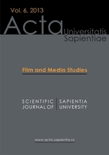
Acta Universitatis Sapientiae-Film and Media Studies
Scope & Guideline
Innovating the Future of Film and Media Studies
Introduction
Aims and Scopes
- Intermediality and Affective Engagement:
The journal frequently examines how different media interact and influence each other, particularly in terms of affective responses and viewer engagement. This includes the study of how intermedial techniques can evoke emotions and create unique viewing experiences. - Cultural Trauma and Memory:
Many publications delve into themes of cultural trauma and memory, exploring how films and media represent historical events and personal narratives. The journal highlights the role of cinema in shaping collective memory and addressing past traumas. - Participatory Media Practices:
The journal emphasizes participatory media, investigating how audiences can engage with and contribute to media productions. This includes participatory video projects and the role of the viewer as an active participant in media creation. - Genre and Aesthetic Analysis:
A significant focus is placed on genre studies and aesthetic analysis, with particular attention to how different genres convey meaning and emotion. This includes the exploration of horror, documentary, and experimental cinema. - Technological and Sensory Approaches:
The journal incorporates discussions about the technological aspects of film and media, including the sensory experience of viewing and the impact of new media technologies on narrative and representation.
Trending and Emerging
- Intermediality in Contemporary Media:
A strong trend in the journal is the exploration of intermediality, particularly how contemporary films and media utilize various techniques to create unique narratives and experiences. This reflects a broader interest in how different media forms influence storytelling. - Affective Intermediality:
The concept of affective intermediality is gaining prominence, as researchers examine how media elicits emotional responses from audiences. This theme connects to broader discussions about viewer engagement and the impact of media on personal and collective emotions. - Participatory and Community-Based Media:
There is an increasing focus on participatory media practices, with studies investigating the role of audiences as active participants in media creation. This trend highlights the importance of community engagement and social impact in media studies. - Crisis Narratives in Film:
Emerging themes around crisis narratives, particularly in relation to socio-political issues, are becoming more prevalent. This includes analyses of how films address contemporary crises, such as environmental issues, social justice, and cultural trauma. - Technological Impact on Narrative and Aesthetics:
The journal is also trending towards exploring the impact of new technologies on narrative structures and aesthetic choices in film and media. This includes discussions on how digital media transforms traditional storytelling methods.
Declining or Waning
- Traditional Film Criticism:
There appears to be a diminishing focus on conventional film criticism that emphasizes auteur theory or traditional narrative analysis. The journal's recent works lean more towards interdisciplinary approaches that incorporate cultural studies and audience engagement. - Static Genre Studies:
While genre studies remain relevant, the exploration of static or fixed genre conventions has lessened. The journal seems to be moving towards more fluid analyses of genre that consider hybrid forms and intermediality. - Historical Film Studies:
The analysis of historical films in a purely historical context is becoming less prevalent. Instead, there is a shift towards examining how historical narratives are constructed through intermediality or affective engagement, suggesting a broader interpretive lens. - Individual Author Studies:
There is a noticeable decline in studies focused exclusively on individual filmmakers or authors. The journal is increasingly favoring thematic and intermedial analyses that contextualize works within broader cultural and social frameworks.
Similar Journals
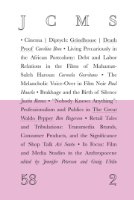
JCMS-Journal of Cinema and Media Studies
Connecting Scholars and Practitioners in Media ArtsJCMS-Journal of Cinema and Media Studies, published by University of Texas Press, stands as a vital platform for scholars and practitioners in the realms of cinema, media, and visual arts. With an ISSN of 2578-4900 and an E-ISSN of 2578-4919, the journal has been a part of the academic landscape since its inception in 2018 and will continue to contribute valuable research until 2024. Notably ranked in the top tiers of Scopus, securing Q1 status in Visual Arts and Performing Arts and Q3 in Communication, JCMS features articles that critically engage with both traditional and contemporary issues in media studies. Located in the United States, the journal is committed to providing open access to a wide array of interdisciplinary research, fostering dialogue among researchers, students, and media professionals. By serving as a nexus for innovative scholarship and creative discourse, JCMS enriches our understanding of cinematic and media practices and their impact on society today.

FILM CRITICISM
Exploring the Depths of Cinematic DiscourseFILM CRITICISM is a prestigious open-access journal dedicated to the study and review of cinema, offering a platform for scholars, critics, and students to engage deeply with the evolving landscape of film. Published by Film Criticism and based in the United States at Allegheny College, this journal has been contributing to film studies since 2002, with recent issues spanning from 2023 to 2024. Registered under ISSN 0163-5069, it is recognized in the Visual Arts and Performing Arts categories, achieving a commendable rank of #372 out of 667 in Scopus, placing it in the 44th percentile of its field. With an open-access policy implemented since 2016, FILM CRITICISM not only broadens accessibility to scholarly work but also enhances the dialogue around cinematic narratives, theories, and critiques. The journal's relevance is underscored by its current Q3 ranking, making it an essential resource for researchers and professionals alike who are invested in the critical examination of film.
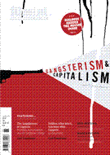
Film International
Diving Deep into the World of Film and Its Narratives.Film International is a prominent journal dedicated to the exploration of film and its cultural, social, and artistic significance. Published by INTELLECT LTD, this journal serves as a platform for interdisciplinary studies in the field of film criticism, theory, and scholarship, contributing valuable insights from both established and emerging researchers. With an ISSN of 1651-6826 and an E-ISSN of 2040-3801, the journal is an essential resource for those engaged in the realms of communication, cultural studies, and visual arts, though it is currently classified in the lower quartiles of these fields (Q4). Noteworthy for its critical perspectives and diverse content, Film International enhances the dialogue surrounding cinematic practices and their impact on society. Researchers, professionals, and students can explore its rich assemblage of articles and reviews that reflect the evolving landscape of film studies, making it a significant addition to the academic community focused on the art of film.

NEW GERMAN CRITIQUE
Advancing Innovative Perspectives on German CultureNEW GERMAN CRITIQUE is a prominent academic journal published by Duke University Press, focusing on the dynamic intersections of German studies, cultural theory, and social thought. With its ISSN 0094-033X and E-ISSN 1558-1462, this journal facilitates a critical dialogue within the Arts and Humanities and Cultural Studies fields. As a Q3-ranked journal in both categories as of 2023, it represents a significant platform for scholars exploring contemporary issues through a German lens, addressing themes of identity, memory, and cultural politics. Although NEW GERMAN CRITIQUE is not an open-access journal, it remains a crucial resource for researchers, professionals, and students interested in the evolving landscape of cultural studies, inviting contributions that foster innovative perspectives and facilitate intellectual exchange. Founded in 1988 and continuing its vital discourse into 2024, the journal is headquartered in Durham, North Carolina, and serves as a touchstone for those engaged in the complexities of modern German culture and its global implications.

Area Abierta
Exploring the Frontiers of Social Science and EducationArea Abierta is a prominent scholarly journal dedicated to the exploration and dissemination of research in the fields of social sciences and education. Published by the Universidad Complutense de Madrid, this journal has embraced an Open Access model since 2001, allowing for unrestricted access to its diverse array of articles and enhancing the visibility of research findings globally. With a commitment to fostering academic discourse and innovation, Area Abierta serves as an essential resource for researchers, professionals, and students alike, providing a platform for critical insights and studies that contribute to ongoing advancements in its scope. The journal's alignment with rigorous academic standards and its role in the scholarly community underline its significance in promoting accessible knowledge and collaborative learning.
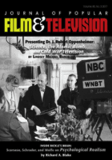
JOURNAL OF POPULAR FILM AND TELEVISION
Exploring the Intersection of Culture and Screen.JOURNAL OF POPULAR FILM AND TELEVISION, published by Routledge Journals, Taylor & Francis Ltd, stands as a significant platform for academic discourse in the realms of cultural studies, visual arts, and performing arts. With its ISSN: 0195-6051 and an evolving digital presence indicated by its E-ISSN: 1930-6458, the journal has carved out a respected niche since its inception in 1978, continuing to contribute to scholarly discussions through 2024. Its impact within the academic community is underscored by a Q3 ranking in Cultural Studies and a Q2 ranking in Visual Arts and Performing Arts for 2023, highlighting its relevance across diverse fields. Notably, with a Scopus ranking placing it in the 74th percentile among visual arts and performing arts journals, it serves as an essential reference point for researchers, professionals, and students committed to the critical examination of film and television. Although not an open-access journal, it provides valuable insights and analysis that enrich understanding of popular media's impact on society. The journal's location in the United States, with a headquarters in Abingdon, England, further affirms its international scope and influence.
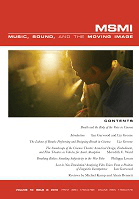
Music Sound and the Moving Image
Illuminating the Intersection of Audio and ImageryMusic Sound and the Moving Image is an esteemed journal published by Liverpool University Press, focusing on the intricate relationships between music, sound, and the moving image. Since its inception, the journal has aimed to foster a multidisciplinary discourse, engaging scholars and practitioners across the fields of musicology, media studies, and visual arts. With an ISSN of 1753-0768 and an E-ISSN of 1753-0776, it has solidified its presence in the academic community, evidenced by its diverse impact reflected in Scopus rankings, including Rank #63/180 in Music and Percentile 65th. The journal's classification in Q3 for Music and its active coverage from 2018 to 2024 enhances its relevance, making it a pivotal resource for researchers and creators who explore the dynamic interplay of sound and imagery. Although currently not available as Open Access, the journal offers a robust platform for peer-reviewed articles, contributing to the advancement of knowledge in this rapidly evolving field.

Journal of African Media Studies
Exploring the Pulse of African Media.Journal of African Media Studies, published by INTELLECT LTD, stands at the forefront of communication research, focusing on the rich tapestry of media practices and theories across the African continent. Since its inception in 2011, this peer-reviewed journal has dedicated itself to exploring the intricate relationships between media, culture, and society in Africa, contributing significantly to the global discourse on communication. With an impressive impact factor positioning it in Q2 of the Communication category for 2023, and ranking #218 out of 511 in the Scopus Social Sciences Communication field, it offers a rigorous platform for scholars and practitioners alike. The journal's commitment to quality research is evident in its robust editorial process and its regular publication of articles that delve into contemporary issues affecting African media landscapes. Despite being a subscription-based journal, it attracts an engaged readership interested in accessing critical insights and advancing knowledge in media studies. As it converges its timeline towards 2024, Journal of African Media Studies continues to be an essential resource for researchers, professionals, and students eager to contribute to and explore the evolving narratives of African media.

Projections-The Journal for Movies and Mind
Pioneering Research at the Crossroads of Film and MindProjections: The Journal for Movies and Mind is a leading scholarly publication dedicated to exploring the intricate relationship between cinema, cognition, and culture. Published by BERGHAHN JOURNALS, this journal has made significant strides since its inception in 2015, achieving impressive rankings in its fields, including a Q1 classification in both Cultural Studies and Visual Arts and Performing Arts for 2023. With an ISSN of 1934-9688 and an E-ISSN of 1934-9696, Projections engages the academic community by delivering innovative research that scrutinizes how films influence and reflect human thought processes and societal structures. While it operates outside the Open Access model, the journal offers critical insights and diverse perspectives that are essential for researchers, professionals, and students alike. With its remarkable impact factor and solid reputation in the arts and humanities domain, Projections serves as an indispensable resource for those dedicated to understanding the psychological and cultural implications of cinematic narratives.
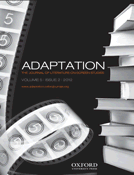
Adaptation-The Journal of Literature on Screen Studies
Bridging Literature and Screen: A Scholarly Journey.Adaptation: The Journal of Literature on Screen Studies, published by Oxford University Press, stands at the forefront of interdisciplinary scholarship, blending the realms of literature, visual arts, and performing arts. This esteemed journal addresses the evolving relationship between literature and its adaptation into various screen formats, providing a vital platform for researchers, professionals, and students interested in the adaptation process across different media. With a commendable 2023 impact factor reflected by its recognition in the Q1 quartile categories for Literature and Literary Theory as well as Visual Arts and Performing Arts, it ranks in the top tiers of its field, showcasing its influence and reach. The journal is dedicated to exploring theoretical and practical approaches to adaptation, ensuring that voices from diverse perspectives are heard. Although it operates under traditional access models, the insights offered in its publications are invaluable for those looking to deepen their understanding of how literature translates into screen narratives. With coverage spanning from 2010 to 2024, Adaptation continues to be a pivotal reference point for innovative scholarship and critical discourse.